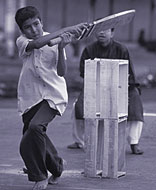 Home > Cricket > Diary archives
Home > Cricket > Diary archivesMay 15, 2001
A matter of money
Prem PanickerThe year is 1993. Not so long ago -- just 8 years back. Cricket was already big business then, and had been ever since the incredible financial success of the 1987 Reliance World Cup, the coming to age of live television, and the hopping, onto the bandwagon, of the corporate sponsor.
That year, this boy, in his very early teens, and possessed of an unusual aptitude for the game, picks up his bat and his kit and is leaving home when his dad asks him, son, where are you off to? Cricket practise, the lad answers. What are you practising so hard for, the father asks.
 The boy, full of his passion for the sport, says, "Dad, the coach told me how much talent I have, he said, I am good, if I practise hard I can get to play for the state... I want that, I want to play for the state, if I do well I'll get to play for India..."
The boy, full of his passion for the sport, says, "Dad, the coach told me how much talent I have, he said, I am good, if I practise hard I can get to play for the state... I want that, I want to play for the state, if I do well I'll get to play for India..."
And the father responds: 'Fine -- and if you are picked to play Ranji Trophy for your state, son, who pays the bills? Any idea what you will be paid, for playing for your state?
The son doesn't know. At that age, he wouldn't. The father knows. He tells the son: 'You don't get paid a single, solitary penny. If you are picked for the state, and you concentrate on cricket at the expense of your studies, I will end up having to feed you for the rest of your life. Put that damn bat back, and get back to your homework.'
Often, we ask, why isn't enough talent coming through. One reason could be that though there are more than enough of those young boys of talent, there are, equally, the same number of aware fathers, who realise that unless you are one of the fortunate few, cricket in this country is not a career option, more so for a middle class boy (and let's face it, cricket in this country is a middle class sport).
Here are some facts and figures: It was in 1994 that payment was first instituted -- and a Ranji player earned the princely sum of Rs 4,000 per game. That figure remained static for 5 years, till 1999. (Do you know of any organisation, industry, whatever, where wages remain static for five years? Barring the richest cricket board in the world, I can't think of one example) Since then, that figure has gone up to Rs 6000 per four day game, and Rs 1500 if the player plays the one dayer as well.
He has to make his own railway bookings, to and fro. Once the match is over, the player then goes back home, submits a bill in triplicate, attaching his ticket and a certificate from his state association testifying that he did in fact play for the state -- and then waits months for the fare to be reimbursed. They stay in accomodations provided by the host stadium -- thus, if the match is at the Wankhede here in Mumbai, the visiting team is put up in rooms at the Cricket Club of India premises.
Contrast this with say a selector. Who flies everywhere (and even submits flight bills when the meeting is in his own city). Who stays only in five star accomodation. Who gets all his expenses paid. And, for attending a Ranji game, gets a total of Rs 12,000, plus a miscellaneous allowance of Rs 3000. All found, remember, because his expenses have already been taken care of.
Given that situation, would you as a father seriously encourage your son to put studies on the back burner and spend more time in the nets?
This is perhaps the best argument in favour of a contract system. The underlying idea underlying is this: It converts cricket into a profession, it guarantees a basic minimum wage. And that means that the youth -- and their parents -- can (and if you look at available examples from elsewhere, will) see cricket in the same light that they see medicine, or engineering, or whatever. Namely, if the kid has the basic aptitude for it, then fine, give him his head and let him follow the dream, because you know that even if he doesn't become Sachin Tendulkar Mark II, he won't find himself begging on the footpath either.
It is not as if the money doesn't exist -- it does. Net -- not, mind, gross -- revenues for the BCCI for the financial year 1998-1999 was Rs 312 lakh; and the corresponding figure for 1999-2000 was Rs 491 lakh.
Central to the contract system is a line of thinking that goes: The cricketers are responsible for the revenues earned by the board. Therefore, it is only fair that the cricketers, too, benefit from the monies earned through their efforts.
Which, in a sense, is nothing more or less than the logic that underlies employee stock options. The employer, in this case the board, is merely telling the employee, to wit the player: The better you play, the more public support the team gets, that in turn translates into bigger gates and more sponsorships, and the more money that comes in, the more you yourself earn.
Which makes eminent sense, no?
Since we have been looking at the Australian model as a starting point for thought, here's a look at how the ACB has worked it.
Each year, the ACB estimates Australian Cricket Revenue from all sources including sponsorship, gate receipts, media rights, merchandising, catering, you name it.
Of the total ACR, 25 per cent goes into a player payment pool. Of this, 55 per cent goes to the nationally contracted players, and 45 per cent to those contracted by the various states.
Both parties are bound by the terms of the agreement -- which, in the latest instance, is four years. And the contract also mandates -- this is a very crucial clause in the context of Indian cricket -- that the players make a minimum number of public appearances to promote cricket, at the national and state levels.
 ``The agreement is important," ACB chief executive Malcolm Speed said in a statement, "in that it provides certainty to Australian cricket (and) is based on what the game can afford to pay. ``The agreement ensures that cricket will be a career of choice for emerging athletes and ensures that Australian players are the best-paid cricketers in the world and Australia's best-paid team sportsmen.''
``The agreement is important," ACB chief executive Malcolm Speed said in a statement, "in that it provides certainty to Australian cricket (and) is based on what the game can afford to pay. ``The agreement ensures that cricket will be a career of choice for emerging athletes and ensures that Australian players are the best-paid cricketers in the world and Australia's best-paid team sportsmen.''
Surely those two key phrases -- that pay is based on what the game can afford, and that the idea is to ensure that cricket becomes the career of choice for emerging athletes -- are equally applicable in the Indian context?
That Australian cricket is slated to produce the game's first millionaire (do note, this refers to the paycheck from the board, not to endorsements that an individual player may command in his own name) is already the stuff of intense discussion. That national cricketers are poised to become the best paid sportsmen in Australia is also too well documented to merit reiteration here.
What is really worth paying attention to, however, is this: As per the latest agreement, players contracted by a state will earn retainers ranging from a minimum of $22,500 to a high of $65,000 over the next year. In other words, the lowest ranked state player is assured of an annual income of $22,500 dollars, as opposed to the Indian system whereby, if you play, they pay you peanuts and if you don't, you don't even get the shells.
Equally, those figures rise to a guaranteed minimum of $37,500 and a maximum of $95,000 by the 2004-'05 -- which means that by that year, the top-ranked state player will command an annual wage of around $140,000.
Does that begin to sound like cricket is a good career option? One with a lucrative present, and a very healthy future?
Now this: The agreement even takes into account the rookies, young and talented players on the verge of state selection. Such kids -- who in the opinion of the selectors are talented enough to make the state side a year or two down the line -- will be placed on retainers at once, and not after they make the grade.
In other words, if that little kid we referred to at the start of this story were an Australian and his father asked him why he was going out to play cricket, he would be able to turn around and say, "Hey, dad, it's because I earn the same kind of money you do, maybe more."
The system for rookies mandates that each state should contract a minimum of two and a maximum of five Under-23 players, the idea being to give those talented kids an incentive to keep playing, and developing their skills. These rookies will get a minimum payment of $10,000 per annum, with that figure expected to reach $17,500 per annum by the year 2005.
$10,000 for a rookie yet to make the state side is the kind of money the captain of the trophy winning Ranji team doesn't make.
We ask, why can't our cricketers be more professional?
Maybe one answer is, you can't treat them like amateurs and still expect them to be professional. An alternative to the existing system would be to think through a comprehensive contract system, from the top down (The ACB, and the players association, finalised the details of the latest contracts over 30 intense meetings), implement it, then tell the players: There you go, no more financial worries for you. You are now professionals, you are as well looked after as it is possible to be. Now get us the results, or get the boot!
That is pretty much the case for the introduction of a contract system. We'll leave you with another quote, from Malcolm Speed:
``We have a very healthy player base. But we want to make sure we don't fall asleep at the wheel. We are on top at the moment, and it's very important that we maintain that position, and we're prepared to spend money to do that.''
Also read:
Points to ponder - Prem Panicker and Faisal Shariff
United we stand - Faisal Shariff
Terms of endearment - Faisal Shariff
Player contracts - Readers' opinion
Money Tree - Prem Panicker
Of the players, by the players... - Faisal Shariff
A question of answers - Prem Panicker
The Rediff Email Diary -- the complete archives
![]()
![]()
Email : Prem Panicker
©1996 to 2001 rediff.com India Limited. All Rights Reserved.